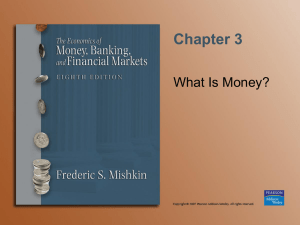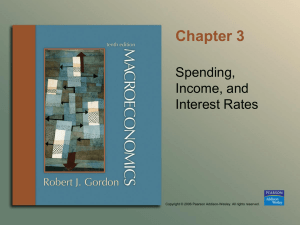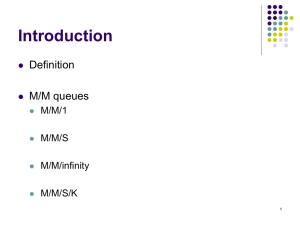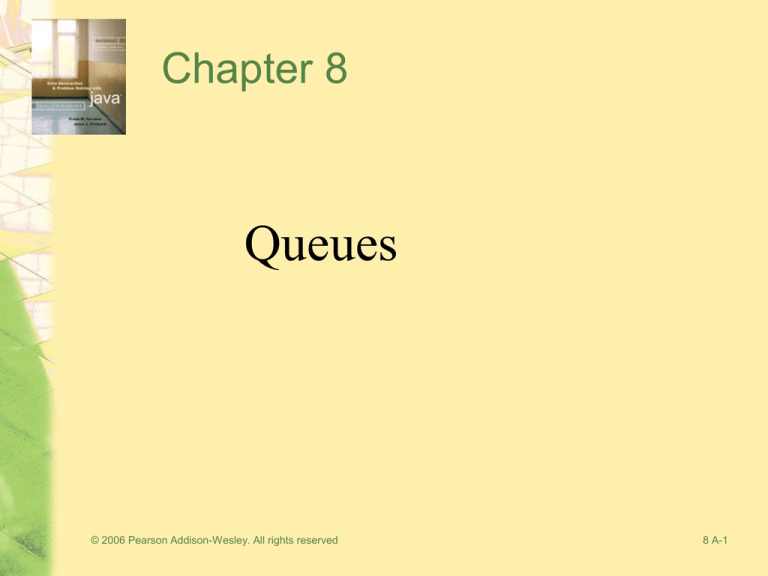
Chapter 8
Queues
© 2006 Pearson Addison-Wesley. All rights reserved
8 A-1
The Abstract Data Type Queue
• A queue
– New items enter at the back, or rear, of the queue
– Items leave from the front of the queue
– First-in, first-out (FIFO) property
• The first item inserted into a queue is the first item
to leave
© 2006 Pearson Addison-Wesley. All rights reserved
8 A-2
The Abstract Data Type Queue
• ADT queue operations
–
–
–
–
–
–
Create an empty queue
Determine whether a queue is empty
Add a new item to the queue
Remove from the queue the item that was added earliest
Remove all the items from the queue
Retrieve from the queue the item that was added
earliest
© 2006 Pearson Addison-Wesley. All rights reserved
8 A-3
The Abstract Data Type Queue
• Queues
– Are appropriate for many real-world situations
• Example: A line to buy a movie ticket
– Have applications in computer science
• Example: A request to print a document
• A simulation
– Discrete event simulator
© 2006 Pearson Addison-Wesley. All rights reserved
8 A-4
The Abstract Data Type Queue
• Pseudocode for the ADT queue operations
createQueue()
// Creates an empty queue.
isEmpty()
// Determines whether a queue is empty
enqueue(newItem) throws QueueException
// Adds newItem at the back of a queue. Throws
// QueueException if the operation is not
// successful
© 2006 Pearson Addison-Wesley. All rights reserved
8 A-5
The Abstract Data Type Queue
• Pseudocode for the ADT queue operations (Cont)
dequeue() throws QueueException
// Retrieves and removes the front of a queue.
// Throws QueueException if the operation is
// not successful.
dequeueAll()
// Removes all items from a queue
peek() throws QueueException
// Retrieves the front of a queue. Throws
// QueueException if the retrieval is not
// successful
© 2006 Pearson Addison-Wesley. All rights reserved
8 A-6
The Abstract Data Type Queue
Figure 8-2
Some queue operations
© 2006 Pearson Addison-Wesley. All rights reserved
8 A-7
Simple Applications of the ADT
Queue: Reading a String of
Characters
• A queue can retain characters in the order in which
they are typed
queue.createQueue()
while (not end of line) {
Read a new character ch
queue.enqueue(ch)
}
• Once the characters are in a queue, the system can
process them as necessary
© 2006 Pearson Addison-Wesley. All rights reserved
8 A-8
Recognizing Palindromes
• A palindrome
– A string of characters that reads the same from left to
right as its does from right to left
• To recognize a palindrome, a queue can be used in
conjunction with a stack
– A stack can be used to reverse the order of occurrences
– A queue can be used to preserve the order of
occurrences
© 2006 Pearson Addison-Wesley. All rights reserved
8 A-9
Recognizing Palindromes
• A nonrecursive
recognition algorithm for
palindromes
– As you traverse the
character string from left to
right, insert each character
into both a queue and a
stack
– Compare the characters at
the front of the queue and
the top of the stack
Figure 8-3
The results of inserting a string
© 2006 Pearson Addison-Wesley. All rights reserved
into both a queue and a stack
8 A-10
Implementations of the ADT
Queue
• A queue can have either
– An array-based implementation
– A reference-based implementation
© 2006 Pearson Addison-Wesley. All rights reserved
8 A-11
A Reference-Based
Implementation
• Possible implementations of a queue
– A linear linked list with two external references
• A reference to the front
• A reference to the back
Figure 8-4a
A reference-based implementation of a queue: a) a linear linked list with two
external references
© 2006 Pearson Addison-Wesley. All rights reserved
8 A-12
A Reference-Based
Implementation
• Possible implementations of a queue (Continued)
– A circular linked list with one external reference
• A reference to the back
Figure 8-4b
A reference-based implementation of a queue: b) a circular linear linked list with one
external reference
© 2006 Pearson Addison-Wesley. All rights reserved
8 A-13
A Reference-Based
Implementation
Figure 8-5
Inserting an item into a nonempty queue
© 2006 Pearson Addison-Wesley. All rights reserved
8 A-14
A Reference-Based
Implementation
Figure 8-6
Inserting an item into an empty queue: a) before insertion; b) after insertion
© 2006 Pearson Addison-Wesley. All rights reserved
8 A-15
A Reference-Based
Implementation
Figure 8-7
Deleting an item from a queue of more than one item
© 2006 Pearson Addison-Wesley. All rights reserved
8 A-16
An Array-Based Implementation
Figure 8-8
a) A naive array-based implementation of a queue; b) rightward drift can cause the
queue to appear full
© 2006 Pearson Addison-Wesley. All rights reserved
8 A-17
An Array-Based Implementation
• A circular array
eliminates the
problem of
rightward drift
Figure 8-9
A circular implementation of a queue
© 2006 Pearson Addison-Wesley. All rights reserved
8 A-18
An Array-Based Implementation
Figure 8-10
The effect of some operations of the queue in Figure 8-8
© 2006 Pearson Addison-Wesley. All rights reserved
8 A-19
An Array-Based Implementation
• A problem with the circular array implementation
– front and back cannot be used to distinguish
between queue-full and queue-empty conditions
© 2006 Pearson Addison-Wesley. All rights reserved
8 A-20
An Array-Based Implementation
Figure 8-11a
a) front passes back when the queue becomes empty
© 2006 Pearson Addison-Wesley. All rights reserved
8 A-21
An Array-Based Implementation
Figure 8-11b
b) back catches up to front when the queue becomes full
© 2006 Pearson Addison-Wesley. All rights reserved
8 A-22
An Array-Based Implementation
• To detect queue-full and queue-empty conditions
– Keep a count of the queue items
• To initialize the queue, set
– front to 0
– back to MAX_QUEUE – 1
– count to 0
© 2006 Pearson Addison-Wesley. All rights reserved
8 A-23
An Array-Based Implementation
• Inserting into a queue
back = (back+1) % MAX_QUEUE;
items[back] = newItem;
count++;
• Deleting from a queue
front = (front+1) % MAX_QUEUE;
count--;
© 2006 Pearson Addison-Wesley. All rights reserved
8 A-24
An Array-Based Implementation
• Variations of the array-based implementation
– Use a flag full to distinguish between the full and
empty conditions
– Declare MAX_QUEUE + 1 locations for the array
items, but use only MAX_QUEUE of them for queue
items
© 2006 Pearson Addison-Wesley. All rights reserved
8 A-25
An Array-Based Implementation
Figure 8-12
A more efficient circular
implementation: a) a full
queue; b) an empty queue
© 2006 Pearson Addison-Wesley. All rights reserved
8 A-26
An Implementation That Uses the
ADT List
• If the item in position 1 of a list list
represents the front of the queue, the
following implementations can be used
– dequeue()
list.remove(1)
– peek()
list.get(1)
© 2006 Pearson Addison-Wesley. All rights reserved
8 A-27
An Implementation That Uses the
ADT List
• If the item at the end of the list represents the back
of the queue, the following implementations can
be used
– enqueue(newItem)
list.add(list.size()+1, newItem)
Figure 8-13
An implementation that uses the ADT list
© 2006 Pearson Addison-Wesley. All rights reserved
8 A-28
The Java Collections Framework
Interface Queue
• JCF has a queue interface called Queue
• Derived from interface Collection
• Adds methods:
–
–
–
–
–
element: retrieves, but does not remove head
offer: inserts element into queue
peek: retrieves, but does not remove head
poll: retrieves and removes head
remove: retrieves and removes head
© 2006 Pearson Addison-Wesley. All rights reserved
8 A-29
Comparing Implementations
• All of the implementations of the ADT queue
mentioned are ultimately either
– Array based
– Reference based
• Fixed size versus dynamic size
– A statically allocated array
• Prevents the enqueue operation from adding an item to the
queue if the array is full
– A resizable array or a reference-based implementation
• Does not impose this restriction on the enqueue operation
© 2006 Pearson Addison-Wesley. All rights reserved
8 A-30
Comparing Implementations
• Reference-based implementations
– A linked list implementation
• More efficient
– The ADT list implementation
• Simpler to write
© 2006 Pearson Addison-Wesley. All rights reserved
8 A-31
A Summary of Position-Oriented
ADTs
• Position-oriented ADTs
– List
– Stack
– Queue
• Stacks and queues
– Only the end positions can be accessed
• Lists
– All positions can be accessed
© 2006 Pearson Addison-Wesley. All rights reserved
8 A-32
A Summary of Position-Oriented
ADTs
• Stacks and queues are very similar
– Operations of stacks and queues can be paired
off as
• createStack and createQueue
• Stack isEmpty and queue isEmpty
• push and enqueue
• pop and dequeue
• Stack peek and queue peek
© 2006 Pearson Addison-Wesley. All rights reserved
8 A-33
A Summary of Position-Oriented
ADTs
• ADT list operations generalize stack and
queue operations
– length
– add
– remove
– get
© 2006 Pearson Addison-Wesley. All rights reserved
8 A-34
Application: Simulation
• Simulation
– A technique for modeling the behavior of both
natural and human-made systems
– Goal
• Generate statistics that summarize the performance
of an existing system
• Predict the performance of a proposed system
– Example
• A simulation of the behavior of a bank
© 2006 Pearson Addison-Wesley. All rights reserved
8 A-35
Application: Simulation
Figure 8-14a and 8-14b
A blank line at at time a) 0; b) 12
© 2006 Pearson Addison-Wesley. All rights reserved
8 A-36
Application: Simulation
Figure 8-14c and 8-14d
A blank line at at time c) 20; d) 38
© 2006 Pearson Addison-Wesley. All rights reserved
8 A-37
Application: Simulation
• An event-driven simulation
– Simulated time is advanced to the time of the next event
– Events are generated by a mathematical model that is based on
statistics and probability
• A time-driven simulation
– Simulated time is advanced by a single time unit
– The time of an event, such as an arrival or departure, is determined
randomly and compared with a simulated clock
© 2006 Pearson Addison-Wesley. All rights reserved
8 A-38
Application: Simulation
• The bank simulation is concerned with
– Arrival events
• Indicate the arrival at the bank of a new customer
• External events: the input file specifies the times at which the arrival
events occur
– Departure events
• Indicate the departure from the bank of a customer who has
completed a transaction
• Internal events: the simulation determines the times at which the
departure events occur
© 2006 Pearson Addison-Wesley. All rights reserved
8 A-39
Application: Simulation
• An event list is needed to implement an event-driven
simulation
– An event list
• Keeps track of arrival and departure events that will occur but have
not occurred yet
• Contains at most one arrival event and one departure event
Figure 8-15
A typical instance of
the event list
© 2006 Pearson Addison-Wesley. All rights reserved
8 A-40
Summary
• The definition of the queue operations gives the ADT
queue first-in, first-out (FIFO) behavior
• A reference-based implementation of a queue uses either
– A circular linked list
– A linear linked list with a head reference and a tail reference
• An array-based implementation of a queue is prone to
rightward drift
– A circular array eliminates the problem of rightward drift
© 2006 Pearson Addison-Wesley. All rights reserved
8 A-41
Summary
• To distinguish between the queue-full and queue-empty
conditions in a queue implementation that uses a circular
array, you can
– Count the number of items in the queue
– Use a full flag
– Leave one array location empty
• Models of real-world systems often use queues
– The event-driven simulation in this chapter uses a queue to model
a line of customers in a bank
© 2006 Pearson Addison-Wesley. All rights reserved
8 A-42
Summary
• Simulations
– Central to a simulation is the notion of simulated time
• In a time-driven simulation
– Simulated time is advanced by a single time unit
• In an event-driven simulation
– Simulated time is advanced to the time of the next event
– To implement an event-driven simulation, you maintain an event
list that contains events that have not yet occurred
© 2006 Pearson Addison-Wesley. All rights reserved
8 A-43

